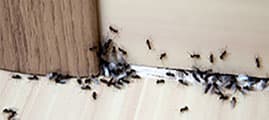
Ant Identification and Ant Inspection

Ant Inspection Locations

Entry Points
Inspect for ants near entry points like doors, windows, electrical wires, and along pipes. Look for cracks in foundational walls.

Moisture Locations
Inspect for ants under and behind sinks, leaky faucets, indoor potted plants, dishwashers, and bathrooms. Outside, look at water puddles, leaky sprayer heads

Food Sources
Inspect kitchen counters, kitchen sinks, food prep, and food storage areas. Indoor potted plants and outdoor plants may that aphis or soft scales, producing honeydew. The honeydew is a food source.
Carpenter Ant Nest Inspection
Carpenter Ants build nests in damp, dead wood, building smooth, distinctive-looking nests.

Ant Inspection Tips
Remember to begin inspection by looking for ant trails, ant entry points, and ant nests.
Some ants never build their nests indoors, while other types do build inside nests. Some ants will follow trails.
Inspect both inside and outside for the ant trails and possible nest sources. If you see some random ants, they may be scouts looking for nesting sites or food sources.
Most of the time, ants do not walk in a straight line, but may randomly walk in a zigzag pattern, looking for new food sources. As they find the food source, the foraging ants leave a pheromone trail for other ants to follow. Look at the overall patterns of the ants.
Since ants prefer moist areas and food sources, inspect these areas.
Please look at the list of ant types below for details for each ant. (Pharaoh ants are almost impossible to determine nesting locations.)
Different Types Of Ants
Ant Control Products
-

-
 Spectre PS AerosolRating:93%
Spectre PS AerosolRating:93%



















